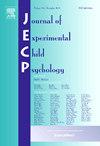Predicting time, shaping control: Unveiling age-related effects of temporal predictability on the dynamics of cognitive control in 5- to 14-year-old children
IF 1.8
2区 心理学
Q3 PSYCHOLOGY, DEVELOPMENTAL
引用次数: 0
Abstract
Understanding how individuals learn to synchronize actions with the temporal structure of their environment is crucial for understanding goal-directed behavior. This study investigated the effects of temporal predictability on cognitive control and action regulation in children aged 5 to 14 years. In our temporally cued version of the Simon task, children were explicitly informed that visual cues would either predict (temporal cues) or not predict (neutral cues) the onset of a target. They used this information to respond to lateralized targets when the target position was either compatible or incompatible with the response hand. Temporal cues speeded reaction times (RTs) to compatible targets in the older (11- to 14-year-old) children and induced a greater number of fast impulsive errors to incompatible targets across all age groups. This pattern replicates previous results in adults and demonstrates that knowing when an event is likely to occur induces a fast, although impulsive, response style. Surprisingly, in the youngest age group (5- and 6-year-olds), temporal cues speeded RTs to incompatible, as well as compatible, targets and helped children to inhibit fast impulsive errors to incompatible targets more efficiently. In summary, the youngest children appeared to effectively leverage the information conveyed by temporal cues to mitigate impulsive response tendencies. However, the benefits of temporal cues on impulse control started to diminish from 7 years of age, when children begin to show more mature inhibitory patterns. Nevertheless, by 11 years of age children achieve performance comparable to that of adults, with faster responses to compatible targets and impulsive responses to incompatible targets.
求助全文
约1分钟内获得全文
求助全文
来源期刊

Journal of Experimental Child Psychology
Multiple-
CiteScore
4.50
自引率
7.70%
发文量
190
期刊介绍:
The Journal of Experimental Child Psychology is an excellent source of information concerning all aspects of the development of children. It includes empirical psychological research on cognitive, social/emotional, and physical development. In addition, the journal periodically publishes Special Topic issues.
 求助内容:
求助内容: 应助结果提醒方式:
应助结果提醒方式:


